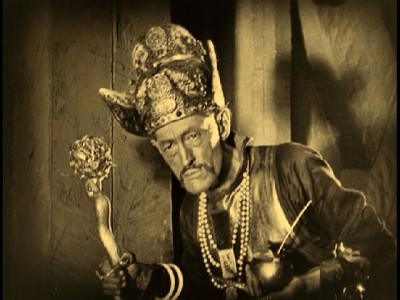
Especially now in its beautiful restoration and decked out with a splendid all Rimsky-Korsakov musical score, Raoul Walsh’s The Thief of Bagdad (1924) is one of the most accessible of all silent film spectacles. Yes, you can argue that is star—and prime visionary—Douglas Fairbanks is sometimes a little much to take (did he really have to show us every tooth in his mouth every time he smiled?). And it is permissible to think that maybe the film didn’t really need to be over two-and-a-half hours long. But in all fairness, this was a huge undertaking—an epic, an extravagant spectacle. It deserved a bit of sprawl and it even warranted at least some of Fairbanks’ overly exuberant personality. In fact, Fairbanks does manage a few scenes with unaccustomed stillness that suggest he was really a better actor than his screen persona generally allowed him to be. But what remains at the end of the day is the sense of having truly seen something quite wonderful, exciting, and ever so much larger than life. The film transports the viewer to an all-consuming fantasy world as few movies have.

A large measure of the film’s success hinges on William Cameron Menzies’ production design. In that regard, Menzies was a true genius. (He was, after all, the man who truly made Gone with the Wind (1939) what it was—far more than any of its credited and uncredited directors.) Menzies gave us a Bagdad that owed much to the art nouveau style of Aubrey Beardsley—and not just Beardsley’s Arabian Nights drawings—but that was also completely his own. Even in those moments with The Thief of Bagdad hits a lull, there’s something so wonderful to just look at that it’s hard to mind. The look Menzies gave to the film is still a marvel, and one that clearly had an effect on the design of the movie palaces of the era, which tried to recreate its sense of the exotic.

It also would be a great mistake to sell the contribution of director Raoul Walsh short. As a director, Walsh dates back to 1913. As a result, he’s still largely an American silent film director, which is to say it rarely occurs to him to move the camera within a scene, relying instead on achieving his effects through editing. What’s odd about this approach—and it’s something common to pre-German invasion Hollywood movies—is that there are numerous instances of elaborate moving camera tracking shots following characters moving through a scene, the minute there’s an intimate or dialogue scene, the camera is pretty completely nailed down. Why it took the influence of German filmmakers to change this is a mystery that will likely never be solved. Regardless, Walsh kept things moving and knew how to show off Menzies’ sets to their best advantage.

Walsh was also able to keep the acting fairly reserved—exempting Fairbanks. The film’s chief villain played by Japanese stage magician Sojin Kamiyama (billed simply as Sojin) gives a marvelously restrained performance. It was only his second film, and he went on to a successful Hollywood career—until sound when his almost incomprehensible accent sent him back to Japan. Anna May Wong as his treacherous spy in the Caliph’s court is, as always, an intelligent and subtle performer. Perhaps the most interesting—and apparently troublesome—member of the cast was Sadakichi Hartman as Sojin’s court magician. (The role was apparently longer, but had to be cut when he simply wandered off out of boredom with the filmmaking process.) The half-Japanese, half-German Hartman was a hanger-on of the John Barrymore, John Decker, W.C. Fields, Will Rogers group, and an incorrigible rogue. He was also a writer, poet, critic, layabout and occasional pickpocket whose antics were entertainingly chronicled in Gene Fowler’s book about that group, Minutes of the Last Meeting (1954). This would be Hartmann’s only film appearance.
However, it has to be admitted that all of this was part and parcel of Fairbanks’ vision—of his desire to make the biggest, grandest, most spectacular movie the world had ever seen. And in all honesty, he came mighty close. The Thief of Bagdad may not be Fairbanks best film, but it’s the most ambitious and probably the best remembered. If you’ve never seen it, you really should.
The Hendersonville Film Society will show The Thief of Bagdad Sunday, Feb. 2, at 2 p.m. in the Smoky Mountain Theater at Lake Pointe Landing Retirement Community (behind Epic Cinemas), 333 Thompson St., Hendersonville.



Before you comment
The comments section is here to provide a platform for civil dialogue on the issues we face together as a local community. Xpress is committed to offering this platform for all voices, but when the tone of the discussion gets nasty or strays off topic, we believe many people choose not to participate. Xpress editors are determined to moderate comments to ensure a constructive interchange is maintained. All comments judged not to be in keeping with the spirit of civil discourse will be removed and repeat violators will be banned. See here for our terms of service. Thank you for being part of this effort to promote respectful discussion.